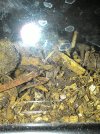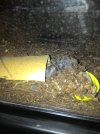-
Are you a Tarantula hobbyist? If so, we invite you to join our community! Once you join you'll be able to post messages, upload pictures of your pets and enclosures and chat with other Tarantula enthusiasts. Sign up today!
You are using an out of date browser. It may not display this or other websites correctly.
You should upgrade or use an alternative browser.
You should upgrade or use an alternative browser.
help plz
- Thread starter birdeater
- Start date
- Messages
- 1,091
- Location
- New Mexico
Not sure, could be scavenger mites which are not a problem in smal numbers. Add isopods to the enclosure, they are a great cleanup crew.
Your substrate looks a little dry for a Theraphosa.
Your substrate looks a little dry for a Theraphosa.
- Messages
- 1,082
"Bird eater" could be described as a few different species. Agree with Scoolman regardless of which one it is. Minimally the humidity should be 75 and as high as 90 for a T. blondi. The mites (if that is what these bugs are as I can't really tell in this photo) could really get worse with more humidity too. Make sure all uneaten food is removed. Personally, I would remove the T and change out the bedding. There looks to be a lot of hard wood in the substrate and if you add moisture, it will lead to bad things. I do have one enclosure that I used this type of bedding on and so far, no issues but I regret doing it now (for one of my Haplopelma lividus sp.). Will change it out myself soon. Good luck.
Agreed, I've had mold issues with wood in the substrate, and not nearly that much wood. That looks like a mulch almost."Bird eater" could be described as a few different species. Agree with Scoolman regardless of which one it is. Minimally the humidity should be 75 and as high as 90 for a T. blondi. The mites (if that is what these bugs are as I can't really tell in this photo) could really get worse with more humidity too. Make sure all uneaten food is removed. Personally, I would remove the T and change out the bedding. There looks to be a lot of hard wood in the substrate and if you add moisture, it will lead to bad things. I do have one enclosure that I used this type of bedding on and so far, no issues but I regret doing it now (for one of my Haplopelma lividus sp.). Will change it out myself soon. Good luck.
I use eco earth coco fiber, mixed with organic topsoil (I sift that now to remove the wood and rock debris) and for the more humid needy Ts i add a handful or so of vermiculite.
It is coco fiber bedding I got it from the pet store where I got my bird eater..Yes I know it does look a little dry I spray down his cage twice - three times a day to keep the humidity up.. I plan on changing out everything this weekend my husband thinks it's the live plant we put in there that caused the bugs.. but idk.. so organic top soil will be best for him?
I took the pic really close up to get a good pic of the little bugs that's why the bedding looks so large"Bird eater" could be described as a few different species. Agree with Scoolman regardless of which one it is. Minimally the humidity should be 75 and as high as 90 for a T. blondi. The mites (if that is what these bugs are as I can't really tell in this photo) could really get worse with more humidity too. Make sure all uneaten food is removed. Personally, I would remove the T and change out the bedding. There looks to be a lot of hard wood in the substrate and if you add moisture, it will lead to bad things. I do have one enclosure that I used this type of bedding on and so far, no issues but I regret doing it now (for one of my Haplopelma lividus sp.). Will change it out myself soon. Good luck.
That's not coco fiber, maybe coco husk. I'd change it out. All those sharp wood edges could injure the T.It is coco fiber bedding I got it from the pet store where I got my bird eater..Yes I know it does look a little dry I spray down his cage twice - three times a day to keep the humidity up.. I plan on changing out everything this weekend my husband thinks it's the live plant we put in there that caused the bugs.. but idk.. so organic top soil will be best for him?
Yes organic top soil would be much better than his current substrate.
- Messages
- 429
- Location
- Idaho, USA
Hold up, those are not mites, those are booklice, like these: http://bugguide.net/node/view/18966. They have the same effect as springtails, just in dryer cages. They shouldn't stress out your tarantula, and they act as a clean up crew. However, the fact that they are breeding in your cage suggests that you may be keeping you T too dry...
I read up on them it says they like moist humid places.. and feed on mold and moisture so maybe I'm keeping the tank top moist? I'm new at this hobby so I'm sorry for all the questions...Hold up, those are not mites, those are booklice, like these: http://bugguide.net/node/view/18966. They have the same effect as springtails, just in dryer cages. They shouldn't stress out your tarantula, and they act as a clean up crew. However, the fact that they are breeding in your cage suggests that you may be keeping you T too dry...
- Messages
- 429
- Location
- Idaho, USA
I read up on them it says they like moist humid places.. and feed on mold and moisture so maybe I'm keeping the tank top moist? I'm new at this hobby so I'm sorry for all the questions...
Hmm, every place I've seen them was extremely dry, they are under my cacti and succulent pots, and it is really dry there.
From the looks of you cage I don't think you're keeping the T too moist, like others have said Theraphosa like it damp.
I mist it with water 2 to 3 times a day to keep the humidity up and everything moist.. I have towels on top to keep the heat in and a heating pad underneath that I uncover to put water on for humidity to.. plus a plant I water for humidity too.. is there anything else I can due I thought about taking a tubaware container and poking holes in the top to put under heating light for more humidity but I don't know how well that would work
- Messages
- 429
- Location
- Idaho, USA
I mist it with water 2 to 3 times a day to keep the humidity up and everything moist.. I have towels on top to keep the heat in and a heating pad underneath that I uncover to put water on for humidity to.. plus a plant I water for humidity too.. is there anything else I can due I thought about taking a tubaware container and poking holes in the top to put under heating light for more humidity but I don't know how well that would work
Your setup sounds good, the cage should be moist enough if you mist it that often.
- Messages
- 1,091
- Location
- New Mexico
Misting only raises humidity for a very short time, you are better off wetting the upper inch of soil, and rewetting as it dries. Do not use a heat lamp, it is going dry out the enclosure rapidly, completely negating your efforts at raising humidity. A small heat mat on the side of the enclosure is sufficient, keep a water dish vise to the heat mat to produce adv evaporative effect.
- Messages
- 23
I'm still fairly new to this, but that kind of looks more like an L. Parahybana than a Therphosa (I didn't see where the op specified what type of bird eater). If so then the high humidity and heat wouldn't be required.
It's supposed to be a pink salmon bird eater that's what we ordered. But when we ordered it it was supposed to an inch but it was way way smaller then that so we will see when he gets bigger. He's a Brazilian spider that's where they originate from so they are supposed to have high humidity and moisture. I researched before we got him. I'm hoping they didn't send us the wrong one cuz I do not want to be doing this all wrongI'm still fairly new to this, but that kind of looks more like an L. Parahybana than a Therphosa (I didn't see where the op specified what type of bird eater). If so then the high humidity and heat wouldn't be required.
- Messages
- 23
That is why it is always better to use the scientific name as opposed to the common name of tarantulas to avoid confusion. Lasiadora Parahybana is a salmon pink birdeater. They do not require extra heat, if the room is comfortable for you then they are fine. Also they do not need to be misted, just keep a full water bowl and you can overfill it a bit about once a week to maintain humidity.
- Messages
- 1,091
- Location
- New Mexico
Well we have a whole different ball game here. L parahybana have completely different requirements than Theraphosa. As stated they do fine at room temps, and a good water dish. I wet the substrate let dry completely, then wet it again for adults. You will want to keep the sub most for your spiderling until it is about 1.5-2".That is why it is always better to use the scientific name as opposed to the common name of tarantulas to avoid confusion. Lasiadora Parahybana is a salmon pink birdeater. They do not require extra heat, if the room is comfortable for you then they are fine. Also they do not need to be misted, just keep a full water bowl and you can overfill it a bit about once a week to maintain humidity.

